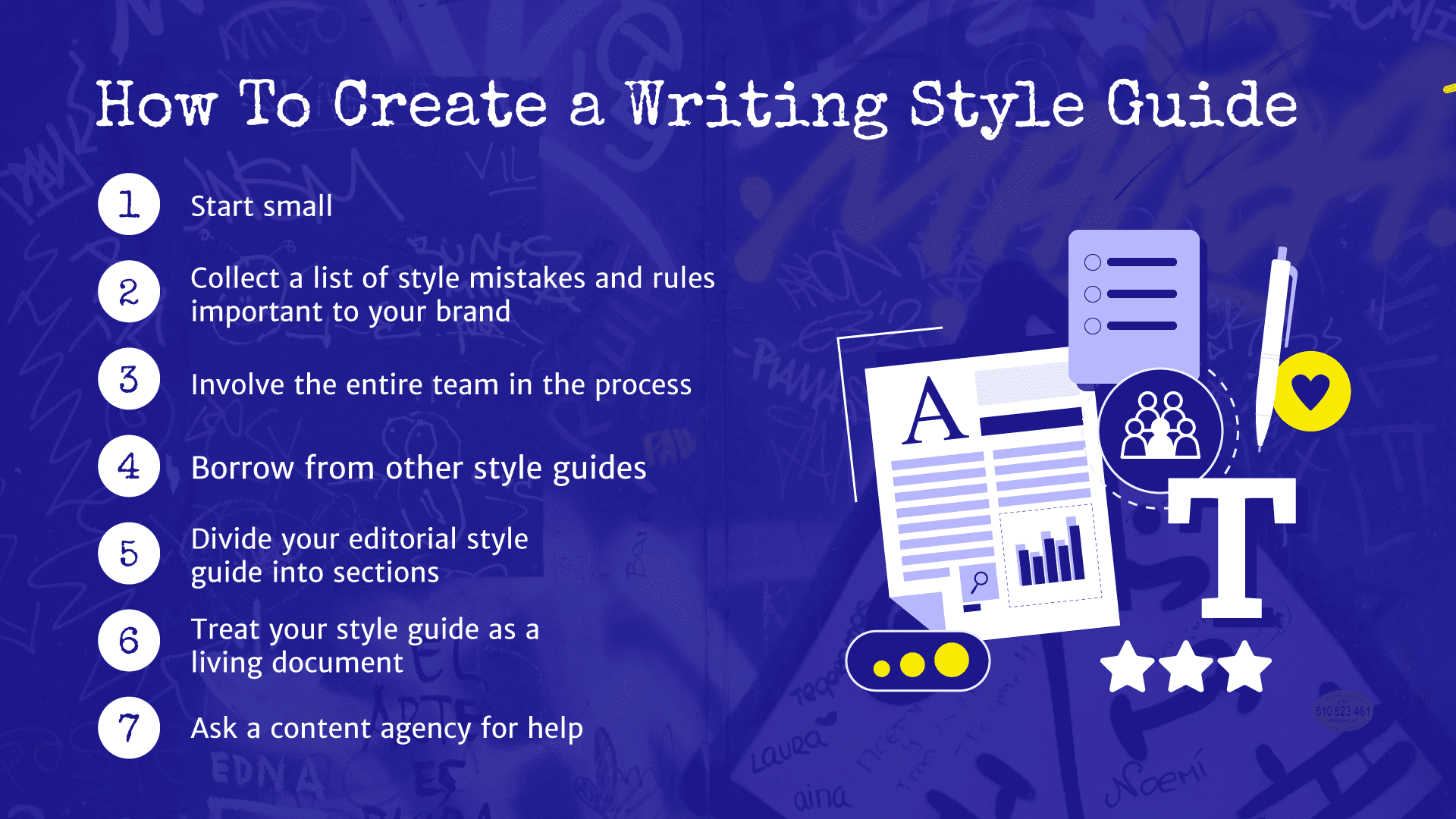As a content marketer or business owner, you likely understand how important it is to be consistent in how you communicate with your audience.
In fact, according to a 2021 report by Marq, consistent branding across all channels can boost profits by up to 20%.
But staying consistent in your brand messaging is far from easy. More often than not, you’ll find yourself investing hours to ensure anyone writing content for your company stays in line with the brand message.
That’s why a brand style guide is so important. A style guide serves as a reference to make sure all of your content follows one unified voice and style, regardless of who’s writing it.
But creating your own style guide can be a daunting task.
So how exactly do you go about it? This guide provides several tips to simplify the process.
Here’s what you’ll learn:
What Is a Writing Style Guide?
A writing style guide is a document that serves as a set of standards and conventions you want your writers to follow when creating content. It ensures consistency in language, brand voice, tone, and formatting and helps create a cohesive brand identity.
In other words, a writing style guide makes sure your content sounds like it’s coming from one source — even if you have several different people creating content for your brand.
Who Needs a Writing Style Guide?
Anyone who produces content for a business can benefit from a writing style guide. This includes social media managers, copywriters, freelancers, and designers.
Whether you have an in-house team of writers or you outsource content creation, creating a style guide ensures everyone will follow the same brand guidelines.
Why You Need a Writing Style Guide
A writing style guide can be beneficial to your company for several reasons:
Maintains Brand Consistency
Creating a content style guide ensures your content is consistent and uniform across all channels, giving customers a clear picture of what to expect from your brand.
This helps create a seamless and reliable customer experience, which can strengthen your brand’s reputation and garner more trust from your target audience.
And that’s a big deal. According to a 2022 Salsify report, almost half of customers are willing to buy more from a brand they trust.

Improves Workflow and Productivity
A house style guide helps new writers quickly become acclimated to your style. It ensures everyone is using the same terminology and formatting, which can save time during the editing stage. And it can even help scale content production and grow your business.
A writing style guide is also an effective way to find out whether a writer is a fit for your team or not. If said writer keeps ignoring style rules and reinforcement edits, you might want to reevaluate their role or find someone else who’s a better fit.
Plus, by giving your writers and editors a set of rules and standards to follow, you’re establishing a shared understanding among your team on how a particular piece should be written and improved.
That means no more wasted time debating over stylistic choices, formatting issues, or whether or not to use the Oxford comma. Why argue when those rules are already laid out in the guide?
Reduces Errors
Errors in your brand’s writing can cost you your reputation and money. For example, if you’re publishing articles for web developers, they probably won’t take your brand seriously if your team members keep writing “WordPress” with a lowercase “p.”
But by providing clear style guidelines and standards for how to write content, you can reduce the likelihood that grammatical, punctuation, or spelling errors will sneak into your published content.
Using a writing style guide also helps your team spot and eliminate errors faster. And you can take that process even further by using a writing tool like Grammarly.
Grammarly doesn’t just identify errors and inconsistencies in your articles, but it also provides recommendations on how to improve them. Better yet, you can implement most of these recommendations with just a click.
Grammarly’s business plan also comes with a style guide feature that enables you to create style rules specific to your brand. This way, everyone on your team can be more consistent in their writing and drastically reduce errors and discrepancies in your content.

Check out our Grammarly review to learn how the tool can speed up the content creation process to help get your content publish-worthy and on brand.
Improves Collaboration Between Writers and Editors
By creating an in-depth writing style guide, editors and content creators can collaborate more effectively. Writers are provided with clear expectations, while editors can quickly identify and address any issues in the content.
Helps Level Up Your Content
A style guide helps level up your content in many ways. For example, it enhances readability by making sure you’re following a consistent structure and format. It also makes your content look more credible and professional by eliminating errors.
By using a style guide, your team becomes more deliberate about creating content that resonates with your audience. It also helps writers get into the right mindset, ensuring what they create is not only relevant and engaging, but also recognizable to customers as a reflection of your brand’s unique voice and values.
Helps Optimize Your Content for Search
Your writing style guide can include guidelines on how to follow search engine optimization (SEO) best practices when creating content, such as:
- How to format and structure docs
- How many target keywords to include
- How to format featured snippets
By including an SEO checklist in your writing style guide, writers and editors will know how to optimize content for search. In turn, that can improve rankings in relevant search engine results pages (SERPs).
How To Convince Your Company That You Need a Writing Style Guide
Now that you know the benefits of creating a style guide, you can convince your company to invest in creating one. Here are some tips to help build your case:
-
Get the timing right. You don't want to present a writing style guide when the company is in crisis mode or if there are other priorities. Instead, wait until the team has the time and resources to focus on creating a style guide.
For example, it might make sense to present your case after the company has released new products or services.
-
Identify the best champion for the initiative. To have the best chance at success, identify a key player who can act as an advocate to champion your initiative.
This person should be able to rally the team around creating a content style guide. Your marketing director or content manager could be good candidates.
-
Ask questions. Talk to key stakeholders and ask questions about what they want from your content. Getting them involved in the process can make them understand the need for a style guide, which can rally support for the initiative.
On top of that, gathering everyone's input ensures the end result meets their expectations.
How To Create a Writing Style Guide
- Start small
- Collect a list of style mistakes and rules important to your brand
- Involve the entire team in the process
- Borrow from other style guides
- Divide your editorial style guide into sections
- Treat your style guide as a living document
- Ask a content agency for help

Here are some tips to help you simplify the process of creating a writing style guide for your business:
1. Start Small
Don’t try to cover every aspect of writing right away. You can start with a few key points — maybe a few lines about formatting or brand personality.
You should keep adding to the guide over time. You can use a writing style guide template to simplify the process.
Your goal isn’t to create a perfect guide on the first try but to create a foundation you can build upon and improve.
Your style guide is never completely finished. As your brand evolves and faces new challenges and trends, you’ll always find opportunities to improve it.
2. Collect a List of Style Mistakes and Rules That Are Important to Your Brand
Create a list of what your writers should avoid when creating content. This list could include overused words, slang, and jargon.
You can also include style rules your writers should always follow, such as:
- How to use capitalization in headings
- How to format abbreviations
- Whether or not to use the Oxford comma
You should also think about how your brand is different from your competitors. Consider the following:
- What words do you use that are unique to your brand?
- What voice does your brand have?
- How do you want that voice to be expressed?
3. Involve the Entire Team in the Process
Get feedback from writers, editors, and anyone else involved in creating content for your brand. Ask them how they think the style guide should be structured and which rules are most important.
By getting your entire team involved in the process, you’re more likely to create a style guide that reflects your company’s brand voice.
4. Borrow From Other Style Guides
You don’t need to create your style guide from scratch. Take a look at how other companies have created theirs and borrow ideas that might work for your brand too.
Here are some style guide examples you can borrow from:

When choosing a style guide to use as your foundation, consider its compatibility with your brand voice and whether it resonates with your target audience.
If your brand is more casual, you might find inspiration from Mailchimp’s Content Style Guide. Going for a more formal tone? The Chicago Manual of Style could be more suitable.
Don’t copy word for word. Take what others have already done and adapt it to your own brand and needs. This can save you a lot of time and help kickstart the process.
In our case, we’ve chosen to base The Blogsmith Style Guide on the AP Stylebook because of its commitment to inclusive language and emphasis on clear and concise writing.
5. Divide Your Editorial Style Guide Into Sections
Your style guide doesn’t have to be one long document. Break it up into sections, so you’ll find it easier to manage.
For example, you can have sections for:
- Grammar rules
- Inclusive language
- How to format numbers and dates
- Buyer personas
- How to cut fluff
Plus, breaking up the guide into sections will make it easier to reference when needed.
And by focusing on one piece at a time, you’ll have an easier time keeping everything organized.
6. Treat Your Style Guide as a Living Document
Your style guide should be a fluid document — one that’s constantly evolving as your brand grows and changes.
Instead of feeling overwhelmed by the pressure of getting everything perfect from the start, think of it as a work in progress that you can continually update as needed.
7. Ask a Content Agency for Help
If you’re feeling lost or unsure where to begin, you can reach out to an SEO content agency like The Blogsmith.
An SEO content agency has the tools, staff, and resources to create a style guide tailored specifically to the unique needs of your business.
An agency can also help you create SEO content that effectively captures your brand’s voice.
Choosing the right content marketing agency not only takes the guesswork out of crafting a style guide but also keeps your content consistent and on brand.
Final Thoughts: How To Create a Style Guide for Your Business — Step by Step
When it comes to creating content for your brand, a writing style guide can give you a leg up over your competition.
The idea of creating one can be intimidating. But by following the tips outlined above, you’ll be able to create an effective and comprehensive style guide that helps you craft content your audience will love to read.
If you’re looking for more tips on how to create a writing style guide that accurately reflects your brand, check out The Blogsmith Founder Maddy Osman’s book, Writing for Humans and Robots: The New Rules of Content Style.
And if you need help creating the perfect style guide for your business, don’t hesitate to reach out to The Blogsmith.












